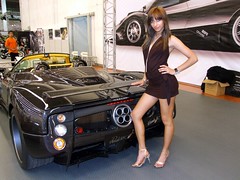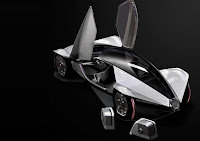Cadillac CTS Sport Wagon, 2010
Based on the hot-selling Cadillac CTS sport sedan, and a sister vehicle to the Cadillac CTS Coupe Concept, the Sport Wagon extends the design-driven renaissance of Cadillac. Following this special premiere at Pebble Beach, the Cadillac CTS Sport Wagon moves to the worldwide auto show circuit this fall - and into Cadillac dealerships in spring 2009.
A striking profile is created with the Cadillac CTS wagon, with a silhouette that suggests speed and aerodynamic efficiency. It rides on the same 113.4-inch (2,880-mm) wheelbase as the Cadillac CTS sport sedan and is 0.3-inch (7 mm) shorter. However, it offers a generous cargo area of 25 cubic feet (720 liters) behind the rear seats. Design highlights include:
* Signature V-shaped deck and tailgate motif
* Large, vertical taillamps with light-pipe technology
* Power-opening liftgate (via key fob or in-vehicle button)
* CHMSL integrated in subtle roof spoiler
* Integrated roof load management system with cross bars for a seamless appearance
* Cargo management system with adjustable in-floor containment
* New 19-inch wheels
* Larger available panoramic rear sunroof
Design details
Dramatic planes highlight the Cadillac CTS wagon's design, including a V-shaped motif carried throughout the vehicle and carefully integrated intersections of exterior surfaces. The elements coalesce in a dramatic fashion, creating tension that emphasizes the vehicle's performance.
The emotion of the Cadillac CTS Sport Wagon's design is carried by a number of nuanced details. The liftgate area, for example, is a confluence of angles and planes that typifies the vehicle's design tension. Cadillac's "V" motif is most prominent here, culminating in a spine at the center of the liftgate that is accented with a subtle spoiler at the top of the backlight. The rear quarter panels extend slightly beyond the inward-angled planes of the V, creating a distinctive W shape at the rear of the vehicle. Large, prominent vertical taillamps - with Cadillac's signature light pipe technology - are the final, dramatic touches to the rear-end styling.
A striking profile is created with the Cadillac CTS wagon, with a silhouette that suggests speed and aerodynamic efficiency. It rides on the same 113.4-inch (2,880-mm) wheelbase as the Cadillac CTS sport sedan and is 0.3-inch (7 mm) shorter. However, it offers a generous cargo area of 25 cubic feet (720 liters) behind the rear seats. Design highlights include:
* Signature V-shaped deck and tailgate motif
* Large, vertical taillamps with light-pipe technology
* Power-opening liftgate (via key fob or in-vehicle button)
* CHMSL integrated in subtle roof spoiler
* Integrated roof load management system with cross bars for a seamless appearance
* Cargo management system with adjustable in-floor containment
* New 19-inch wheels
* Larger available panoramic rear sunroof
Design details
Dramatic planes highlight the Cadillac CTS wagon's design, including a V-shaped motif carried throughout the vehicle and carefully integrated intersections of exterior surfaces. The elements coalesce in a dramatic fashion, creating tension that emphasizes the vehicle's performance.
The emotion of the Cadillac CTS Sport Wagon's design is carried by a number of nuanced details. The liftgate area, for example, is a confluence of angles and planes that typifies the vehicle's design tension. Cadillac's "V" motif is most prominent here, culminating in a spine at the center of the liftgate that is accented with a subtle spoiler at the top of the backlight. The rear quarter panels extend slightly beyond the inward-angled planes of the V, creating a distinctive W shape at the rear of the vehicle. Large, prominent vertical taillamps - with Cadillac's signature light pipe technology - are the final, dramatic touches to the rear-end styling.
Powertrains
Direct injection technology helps the Cadillac CTS offer more power while maintaining fuel economy and lowering emissions. It delivers fuel more precisely to increase the efficiency of combustion. This means less fuel is consumed and lower emissions created.
With the Cadillac CTS Sport Wagon's 3.6L V-6, direct injection translates to 304 horsepower (227 kW)*, no loss of fuel efficiency and a 25-percent drop in cold-start hydrocarbon emissions. It also runs on less expensive regular unleaded gasoline. The Sport Wagon's fuel economy is expected to be similar to the peak rating of the existing sport sedan's 26 mpg highway rating. The standard 3.6L VVT engine that produces 263 horsepower (196 kW) and 253 lb.-ft. of torque (343 Nm) serves as the base engine in North America.
Just like the Cadillac CTS sport sedan, the V-6 engines are matched with fuel-saving six-speed transmissions, including an Aisin six-speed manual or an electronically controlled Hydra-Matic 6L50 six-speed automatic. As is the case on the sport sedan, Cadillac CTS Sport Wagon includes AWD as an option.
An efficient 2.9L turbo-diesel engine is being developed for Cadillac CTS models primarily in European and Asian markets. It is a compact, dual overhead cam, four-valve V-6 engine from GM's family of diesel engines that delivers optimal fuel economy as well as reduced emissions and noise. The engine is rated at 184 kW (250 hp).
Driving dynamics
The robust and dynamic CTS chassis infuses the new wagon with a great balance of performance and luxury. It uses an independent short/long arm ( SLA) front suspension system and a multi-link rear suspension.
The multi-link rear suspension features a fully isolated subframe that helps deliver excellent suspension kinematics, contributing to a superior ride and excellent handling.
Cadillac CTS Sport Wagon Preliminary Specifications
* Vehicle type: four-door, five-passenger rear-wheel-drive/all-wheel-drive wagon
* Wheelbase: 113.4" / 2880mm
* Length: 191.3" / 4859 mm
* Width: 72.6" / 1842 mm
* Height: 59.1" / 1502 mm
* Track: 61.8" / 1570 mm (front); 62" / 1575 mm (rear)
* Engines: 3.6L VVT V-6 (263 hp / 196 kW) 3.6L V-6 VVT DI (304 hp / 227 kW)
* Transmissions: Aisin six-speed manual or Hydra-Matic 6L50 six-speed automatic
* Suspension: four-wheel independent: MacPherson strut front; multilink rear, progressive rate coil springs, monotube shock absorbers
* Steering: variable-assist rack-and-pinion
* Brakes: four-wheel disc; aluminum or iron dual-piston front calipers; aluminum or iron single-piston rear calipers
* Wheels: 17-inch, 18-inch or 19-inch aluminum
* EPA luggage capacity: 25 cu ft / 720 l (behind rear seats)
* EPA total volume: 121.9 cu ft / 3452 l

































































